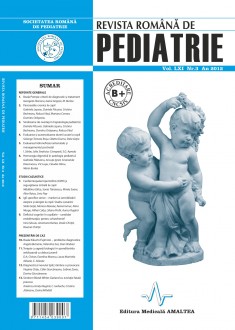SELECT ISSUE

Indexed

| |

|
|
|
| |
|
|
|

|
|
|
|
|
|
|
HIGHLIGHTS
National Awards “Science and Research”
NEW! RJP has announced the annually National Award for "Science and Research" for the best scientific articles published throughout the year in the official journal.
Read the Recommendations for the Conduct, Reporting, Editing, and Publication of Scholarly work in Medical Journals.
The published medical research literature is a global public good. Medical journal editors have a social responsibility to promote global health by publishing, whenever possible, research that furthers health worldwide.
Overlap syndromes in pediatric hepathology
Daniela Pacurar, Gabriela Lesanu, Cristina Becheanu, Dumitru Oraseanu and Raluca Vlad
ABSTRACT
In hepathology, the term “overlap syndrome” describes different forms of hepatobiliary autoimmune disease: autoimmune hepatitis (AIH), primary biliary cirrhosis (PBC), primary sclerosing cholangitis (PSC), autoimmune cholangitis (AIC). Patients with hepatic overlap syndrome present with both biochemical and histological features of at least two of AIH, PBC, PSC. In the absence of appropriate treatment, the course of the disease in autoimmune hepatitis and overlap syndromes is towards cirrhosis and liver failure. It remains unclear whether these overlap syndromes are distinct entities or variants of the major autoimmune hepatopathies. Standardization and diagnostic criteria for overlap syndromes are not yet established and the term “overlap syndrome” is common in clinical practice, but not always used correctly. Empiric medical treatment of overlap syndromes includes anticholestatic therapy with ursodeoxycholic acid and immunosuppressive therapy with corticosteroids and azathioprine in a case to case based therapy schedule. In end-stage disease, liver transplantation is the treatment of choice.
Key words: hepatitis, child, overlap
